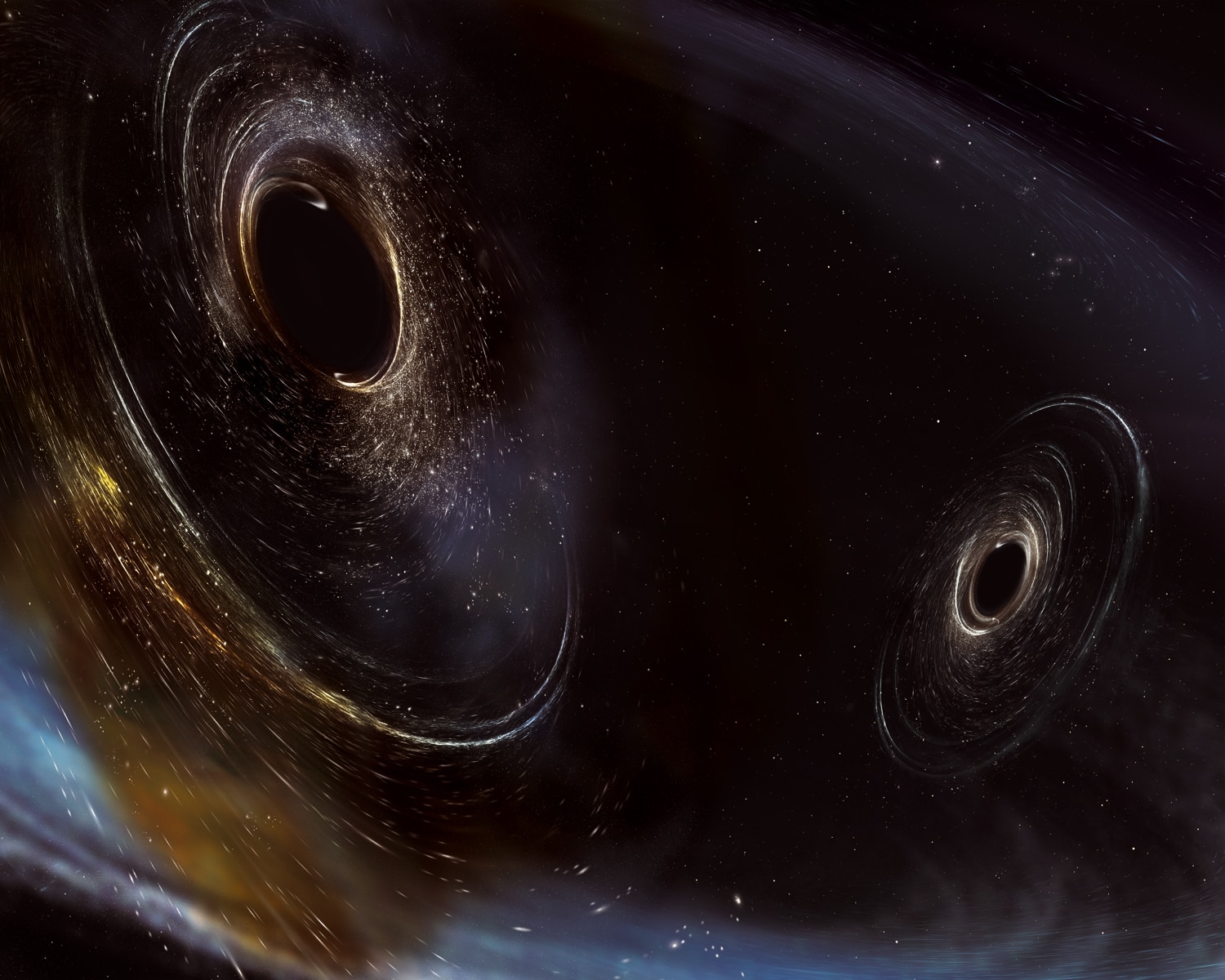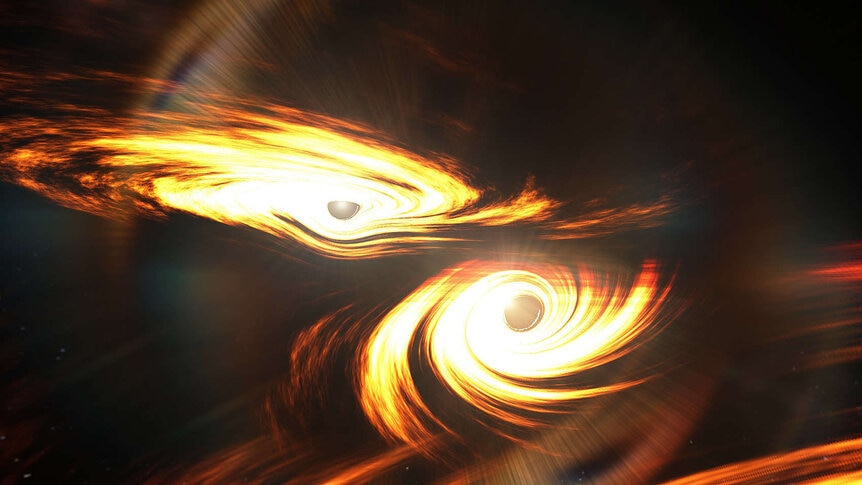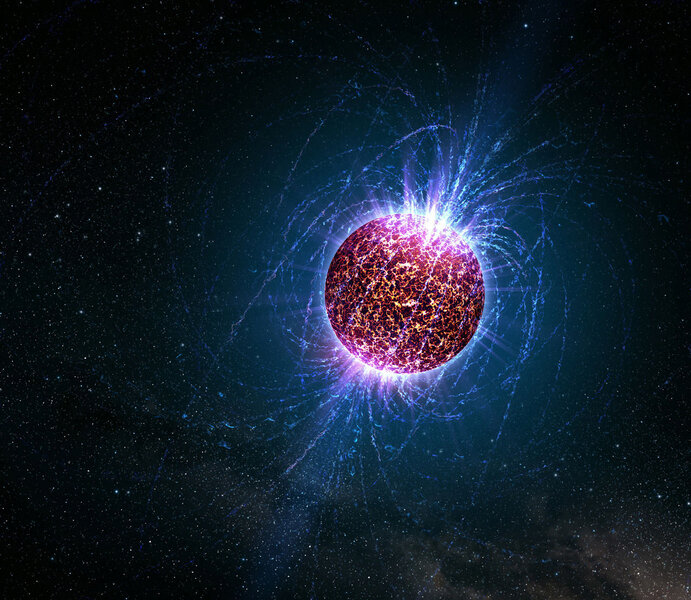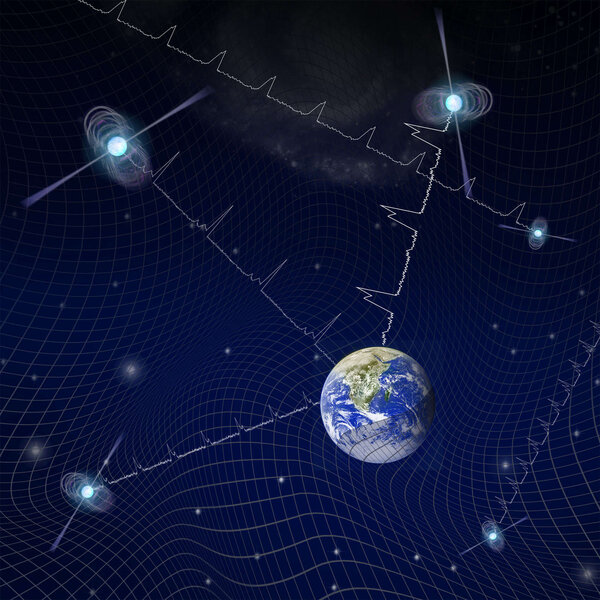Create a free profile to get unlimited access to exclusive videos, sweepstakes, and more!
Astronomers may be hearing the whisper of billions of black holes merging across the Universe

Have you ever been in a loud, crowded room (remember those?) and thought you heard a familiar voice or your name being called? Something just loud enough to perk your ears up but not so loud you can be sure you heard it?
An international team of astronomers is in that same situation right now. Except that the crowded room is the Universe, the people in it are colossal black holes eating each other, the voices are waves compressing spacetime, and instead of ears astronomers are using several dozen pulsars spinning madly across the galaxy.
Right. Let's take a step back.
A major (one could even say "massive") success of Einstein's Theory of General Relativity is the confirmed prediction that when a mass accelerates, it creates ripples in the fabric of spacetime. These are called gravitational waves.
They're stronger for very massive objects being accelerated rapidly, so the strongest source we know of is when a pair of orbiting black holes merge. They're very massive, and just before they merge they move at very nearly the speed of light around each other. The energy they emit in gravitational waves hen they merge is ridiculous, dwarfing the combined energy emitted by all the stars in the galaxy! But by the time these waves reach us they are so weak it takes phenomenal effort to detect them at all.
After decades of searching, this effect was first directly detected in September 2015 by the Laser Interferometer Gravitational-Wave Observatory. It was a major achievement, and since then dozens more have been positively IDed.
LIGO is sensitive to the gravitational waves emitted just moments before and as the two black holes merge; those waves have a pretty high frequency, in the dozens to hundreds of Hertz — a wave with a frequency of one Hertz (Hz) means one wave passes by you per second, two Hz is two per second and so on.
However, as the black holes approach each other over millions or even billions of years they're still emitting gravitational waves, but at much lower power and much much lower frequency. Since supermassive black holes (very massive ones in the center of galaxies) merge somewhere in the Universe every few minutes, that means there are many billions of them out there still on approach, emitting extremely low frequency gravitational waves, as low as a few nanoHertz — meaning one wave passing you every decade or two.
So yeah, low frequency. And there are billions of them coming from the sky in all directions, from all those black holes everywhere in space, which means they all add up to a background hum of these waves arriving at Earth, like voices in a crowded room. LIGO doesn't detect them because they're too low frequency, but there's another way to "hear" them.
Neutron stars are the ultra-dense collapsed cores of massive stars that have exploded. They have the mass of the Sun but are only a dozen or so kilometers wide; a cubic centimeter of neutron star stuff would weigh about as much as all the cars in the USA combined.
They have intense magnetic fields, and this can sometimes cause them to emit very powerful twin beams of radiation away from them. Neutron stars also spin very rapidly, so these beams sweep across space like the beams from a lighthouse. From Earth we see them pulsing with blips of radio energy as these beams pass over us, and we call these kinds of neutron stars pulsars.
Some spin extremely rapidly, hundreds of times per second; these are called millisecond pulsars and because they're so dense their spin is extremely stable. We see these blips of energy at very discrete time intervals, making pulsars incredibly accurate clocks.
This is the very fun part: When a gravitational wave passes through the Earth, it literally compresses and expands space and the Earth itself. The effect is so tiny that you'd never feel it, and even LIGO barely detects it... but then the actual stretching is so small that even on the scale of our entire planet the Earth only changes size by the diameter of an atom or so. These are extraordinarily small effects.
But millisecond pulsars are extraordinarily accurate clocks. If you're observing one with a radio telescope when a gravitational wave passes through the planet, it changes the distance between the radio telescope and the pulsar, which in turn changes their relative distance. Again, the effect is very small, and trying to see it in a single pulsar is nearly impossible.
But if you have a lot of pulsars to look at, and watch them over decades, it's possible to detect that background nanoHertz hum from supermassive black holes all over the Universe as they spiral in toward each other.
Man, that was a cool sentence to write.
Anyway, that's what the North American NanoHertz Observatory for Gravitational Waves (or NANOGrav) is doing. They have been observing 47 millisecond pulsars for 12.5 years, hoping to find that signal. They're particular about the data — the pulsars need to be very stable, for example, and they need to get data from each for at least three years — but 45 of the 47 have fit that bill.
And lo, they have found a signal in their data they can't explain away just yet. They've accounted for all sorts of possible sources, including errors in their observations, the complex motions of the Earth as it orbits the Sun (and in turn the effects of the other planets orbiting the Sun), and more.
The signal persists.
The thing is, it's not quite good enough to claim it's from all those monster black holes eating each other all over the cosmos. It has some of the right characteristics, but they haven't detected it well enough to find some of the more subtle aspects that would nail its source down. To do that they need more pulsars and more time; given the frequency they're observing, a longer time baseline is important.
Still, this is pretty exciting. It shows they're on the right track, and they've found something, even if they can't be completely sure what it is.
They use the huge Green Bank Telescope in West Virginia and the Arecibo dish in Puerto Rico for their observations, and the recent loss of the Arecibo observatory is a big blow. While there's some movement in rebuilding the observatory, that will take some time, so in the meantime they're looking for more collaborators and more telescopes.
I hope that this new announcement helps them find the necessary support. It's staggering to think about detecting this hum, the gentle buzz of spacetime vibrating as these incredible objects approach each other, heading for a merger event so colossal that it can emit as much energy as all the stars in the Universe combined yet be completely invisible unless you watch for its effects on other super-dense objects spread across the galaxy.
This is Star Trek-level stuff, but we're doing it now. Amazing.































